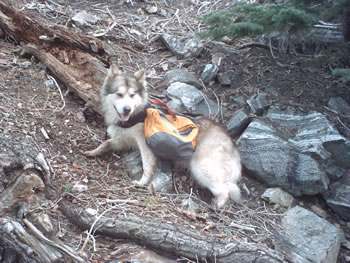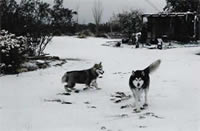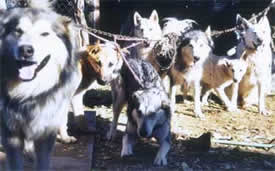Malamute Activities

To the left is Wily. He was encouraged to climb a little hill for a photo-op while on a pack trip.
Here you will find information about what kind of fun you can have with your Alaskan Malamute. Activities for this type of breed include trail sledding, backpacking, winter mountaineering, summiting, weight-pulling, and much more. Dont forget most of this is alot of fun and is meant to be. Read on to learn more about these activities and to see what you might like to do with your dog.
Essentially there are a lot of breeds that are comfortable working as pullers or trail packers. Those breeds include the malamute, husky, or just about any other Nordic breed draft(pulling) dog or even most well behaved large breed sporting and working type dogs.
Activity Ideas
If you live in or near a cold climate zone, know where to find a level snowy surface like a fire road, have a malamute or 3, and have a pair of Skis or are good at snowboarding, try Skijoring.
If you live in or near a cold climate zone that has some good snow pack or icy conditions, have 3 malamutes or more, and want to try a hand at being pulled in a sled, take a look at some prices for a basic basket sled.

Aly as a pup, and her senior Rajah on the right, were playing in the snow in the front yard on one fine snowy day in winter.
If you live in a cold climate, have good snow pack, or icy conditions, and are near wilderness, have good malamute training skills, some well behaved healthy dogs, and have more than 4 Malamutes, take a look at a toboggan sled.
If you don't live in a cold climate and would like to come up with some late autumn, and winter activities, you can look into bicycling with your malamute. You can attach a springer to your bike that will allow your mal to pull you without getting tangled, and also have some shock absorption so your Mal will pull better. Check the outfitters links on this page for this piece of equipment. It's usually too hot in the summer to do this activity if you live anywhere inside the 45th parallel (latitude). Be careful not to overheat your dog. Be careful with what terrain you choose because I've seen Mals feet with their entire pads separated from blister from running too hard on dirt terrain with untrained feet. Please pay very close attention to their pads at all times. Some general rules apply. Let them pull you, don't ride faster than them or use your bike to get ahead and pull them by all means. Do not rush them, and take good care of their feet. Get them some good booties if in doubt of terrain. Homemade booties can mess up their feet if made wrong.
If you love to hike, in any weather (in fact, the worse(cold and stormy) the weather, the better for the Mal), then look into getting a dog pack. You can take some dog food and some water and treats an put in into the dog pack, and maybe tie a small rolled dog blanket on the top to go hiking or overnight packing with your dog. Do not overload the packs with weight, the dog will be completely sore if not used to it and keep an eye on the pads of the feet.
Tip; when going down hill, make the dog walk behind you instead of trying to stop them from pulling, and; carrying a walking stick and swinging it out when they try to pass will greatly ease keeping them behind you if they are the leader type.
Tip; when going up hill, let them pull you as hard as they wish, it helps the climb, and gives them good exercise. This is another reason you never want to discourage them from pulling. Attaching a dog lead to a waist helps to ease the back.

This is The rest of the team, connected to the ATV trainer!(It has ggod brakes) Rajah who is in the lead is not pictured. They are currently tied up behind Rajah the best lead dog for just about any job. Pictured from right to left working back; Nikita, Timbre, Daisy, Alyeska, Kobuk and Odin to the far left .Behind the fence from left to right; Mini, Jimeny, Sitka. Notice, they are all smiling because they are exhilarated before going on this run. And the ones behind the fence don't look so happy.
Packing

Pictured to the left is Rajah as eager as ever to move ahead on a pack trip. He was dawning the old army style satchel bags in which contained some dog food and water.
He also had on his collar that had very large spikes on it, incase of a mountain lion incase of an animal attack.
If your in the wilderness, and you lose the trail or find or feel that you might be lost, Let the Malamute guide you back. They may not take you to the point that you lost the trail, they may instead take a shortcut, but they WILL get you back home! If you can, let them off the leash, they are much more likely in finding a hard trail this way as they can double back as often as necessary. More likely they will B-line towards the trail that in the closest direction of what direction your heading. You get more response usually when heading home, rather than heading into the heart of the wilderness unless the dog is experienced. They still navigate the trails excellently going-in too, because they love to explore. If the weather is a complete whiteout, and the terrain is fresh deep snow, the Malamute will still guide you. If the wind starts to cut more than 40mph and temp drops scores below freezing, then the dogs can get disoriented as well, and that would dictate a time to pull out the overnight bivouac sack for the dog, and then the other for yourself. I hike with my dogs in all weather, and the colder it is, the better they perform. There has been times when it was scores below freezing and they wanted to sleep out in the weather, rather than in the tent out of the weather. They sure feel at home, and get quite a rush. If packing with your dog, let them carry in their own blanket so they don't rip a hole in the bottom of the tent if you let them stay inside, and keep the bottom horizontal tent zipper unzipped so they can get out if they have to, its easy, lest you wake up from unpleasant scents, or you could end up with a ripped tent. A small polyester lap blanket rolled up and tied onto the dog pack works fine, and looks just too cool! Rajah above was wearing twin U.S. issue gas mask duffle's converted into dog packs. Poor dog, we had graduated since then, and ended up with a much better pack.
Mountain Biking
Mountain biking is a fun thing to do with your dog if your very careful. Some of equipment that you would need for this activity is a harness fitted to your dog, and some dog booties for all 4 feet. The next piece of equipment is for the connection of the harness lead. The safest way for your dog, and yourself is to use whats called a springer. It is a device that bolts to your bicycle and is the main connection point for the dogs harness lead. The other way to do this is only marginally safe for the dog only, and not safe for the biker much at all. Assuming your careful and pay attention and have decent reaction time when brakes are needed , then you would need an old tire tube for suspension, or some sort of industrial sized rubber banding or material. You can also use surgical tubing if you have enough of it. You would make yourself a loop of this material anywhere between 2-6ft if possible, and slipknot it over the gooseneck, and connet a long(12-15ft) harness lead to this. Then the trick is to ride the brakes to keep the line taut.
Back in the early days of my Northern Breed experience, I took Rajah on some mountain bike pulls through the mountains along some fire roads for fun, exercise, and training. It was before i had a springer for the bike, so i literally had him bunjied(Mntn. bike tire tube doubled into 2 circles, for the suspension) around the neck and to a threaded D ring which coupled that to 6ft. of thick dog leash webbing to a swivel (the obvious weak link in the rig), then to a 6ft. Rock Climbing runner, with a locking caribiner at the power end. Crazy, yes, however, it worked pretty well, and you have to get real good at braking fast so you don't slack the line too much because it will and does get caught in tire frequently if your not quick. I would NOT advise this method, it was a learning experience.
No matter what method you end up trying, You have to be careful of your pal that's working in directly in front or next to you. Keeping the speed DOWN, and an eye on each of the dog foot pads is absolutely crucial. Of course you need to stop to do this. A dog can be greatly injured if great care isn't taking when biking with them.
Safety First
With all these suggestions as to what kinds of activities you can do with your Malamute, here is a few tips that may help avoid injury to your dogs.
Malamutes are not built for speed. They are freighting dogs, not racing dogs. It is some times thought that malamutes are used to run at full pace, and "go fast". Actually the opposite is true. They need to be kept at an easy pace if running them. First of all, overheating is the biggest danger.
Their feet may get damaged, and you may prematurely wear their bodies out, and they may suffer from bone and joint problems when they get older if you don't pay close attention to what they try to tell you when working them. Look at warning signs, Malamutes have an uncanny way of letting you know when they don't like something. It is your responsibility to learn all of these signs. Some are more subtle than others. Pay close attention to your dog when working it. Remember, their health and happiness comes first if you and your dog are to have a good time.
Be careful not to discourage your tractor-trailer from pulling when walking on a leash! They are built, born, and bred for pulling. It will change their behaviour if you continually do reverse jerks on the leash. It will teach them the bad habits, one of which is of looking back more than forward, and its counter productive to this interest. Look into a different dog breed if you don't want a dog that pulls you when you walk it on a leash. Instead, anticipate it, take advantage of this trait, form an activity around it!

Back in the early days, a long chain was used to tie out the dogs, and some gang lines and neck lines were used to keep the dogs seperated. This was to help get them harnessed up for runs. From left to right, Odin, Chief, Nikita, Mini above her, Aly, an unrecognized pup, Timbre just behind Kobuk, and Kobuk on the far right.
Be very careful not to overheat your Malamute. Heat is the biggest threat to a lot of Nordic breed dogs. when running your dog, If they are panting frantically, and don't want to run any more, don't force them, let them cool down. They need to build up endurance and experience . In warmer climates, If a garden hose is available, hose them down. A good way is to grab them by the collar and then press the hose against the fur until its soaked.
In emergency situations if your dog gets overheated, immediately wet the top of their heads down with cold water to cool off the blood flow through the head. You shouldn't expect much if the water is just poured on, their fur is water resistant. You have to sort of rub it in with your fingertips. Then continue to the face and feet which is the extent of heat-shed areas.

